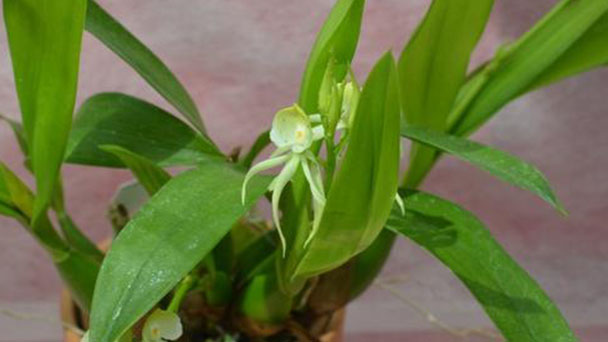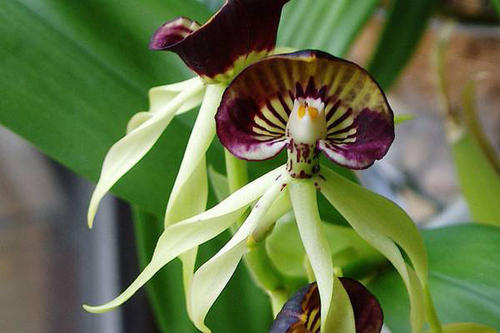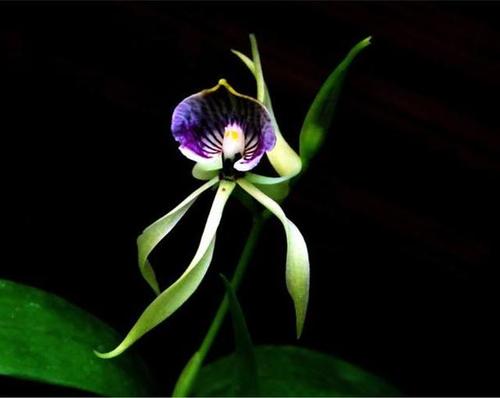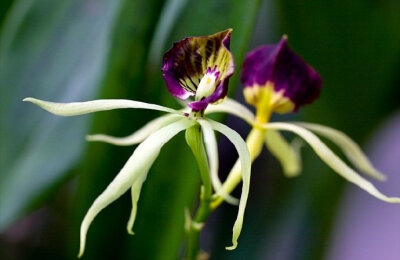Clamshell Orchid (Prosthechea Cochleata) Info, Care & Propagation
Written by Maggie
Oct 14 2021

Clamshell Orchid (Prosthechea Cochleata), with linear, yellow-green wing valves and sepals, slightly twisted and naturally drooping, is named Clamshell Orchid because its lip valve looks like a beautiful scallop shell. It looks like a small octopus of the sea king. Flower shape likes octopus, if the lip scallops, long in the upper part, slightly curved, yellow-green front with purplish brown thick stripes, both sides of the dark purple, white base, two yellow pleats for the column block most, exposed part just like the octopus eyes. Petals and sepals are yellow-green, spotless, linear, subequal, reflexed to the lower part of the labellum, pendulous, slightly twisted, like the long legs of an octopus that float freely and play.
Octopus orchid is native to Central America, West Indies, Colombia, Venezuela and Florida of the United States and other places. Due to its unique flower appearance and long flowering period, many varieties have been cultivated in horticulture and are well received by people.
Clamshell Orchid Picture

Clamshell Orchid Characteristics
Clamshell Orchid flower shape is like octopus, if the lip scallop, long in the upper part, slightly curved, yellow-green front with purplish brown thick stripes, both sides of the deep purple, white base, two yellow pleat for the column block most, exposed part just like the eyes of the octopus.
Petals and sepals of clamshell orchid are yellow-green, spotless, linear, subequal, all reflexed to the lower lip, pendulous, slightly twisted, like the long legs of an octopus drifting freely and playing.
Clamshell Orchid pseudobulb is flat elliptic, 10 ~ 20 cm long. Their wings and sepals are linear, yellow-green, slightly twisted and naturally drooping. They look like small octopuses of the genus Neptacle in the King of Pips, hence their name. Clamshell Orchid is also called because the lip valve looks like a beautiful scallop shell. It is a kind of epiphytic orchid with high ornamental value because of its unique flower pattern. Pseudobulbs are oblate, racemes extruding from pseudobulbs, labellum purplish black with yellow stripes, distally located at flowers, inverted to form a scallop-like covering style; The flowers open in succession and bloom for four to five months.
Clamshell Orchid Native Habits
Clamshell Orchid grows in forests ranging from sea level to 2,000 m above sea level, and in its native regions, from low tropical elevations to cool alpine regions. Different species in different places of origin have different requirements on cultivation environments. Low tropical species and hybrids usually without significant dormancy; The cultivars at high altitudes had obvious dormant periods. All species of this genus require sufficient moisture and high air humidity during the growing season. The plants of Clamshell Orchid have a large volume and need a large amount of fertilizer during the vigorous growth period, so they need to apply liquid compound fertilizer once every 1-2 weeks. Clamshell Orchids also like bright sunlight and grow weakly and flower poorly in lack of sunlight.Summer sunny shading amount %50 or so, winter north is not fast overcast.
Clamshell Orchid Care
Clamshell Orchid Lighting Requirements
Place Clamshell Orchids in bright, oblique sunlight. One proper choice is an east-facing window the place the plant is uncovered to morning daylight however blanketed from warm afternoon solar that may additionally scorch the leaves. You can additionally area the plant underneath fluorescent bulbs.
Clamshell Orchid Temperature Care
Clamshell Orchid flowers don’t do nicely in extraordinarily excessive temperatures. Ensure room temps are beneath eighty five F. (29 C.), and at least 15 stages cooler at night. Water: As a widespread rule, Clamshell Orchid plant life wants water about as soon as each and every week or now and again a little extra often, the usage of tepid water or rainwater. Allow the soil to come to be nearly dry between watering. Reduce moisture throughout the wintry weather months.
Clamshell Orchid Fertilizer
Feed Clamshell Orchid plant life each different week at some point of the developing season the use of a balanced, water-soluble fertilizer with an NPK ratio such as 20-20-20. Feed the plant solely when the soil is moist. Withhold fertilizer for the duration of the winter.
Repotting Clamshell Orchid
Repot the plant when the container turns into too snug. The satisfactory time for repotting orchids is quickly after a new boom seems in spring. Humidity: Clamshell Orchid vegetation decides on a humid environment. Place the pot on a tray of damp pebbles to enlarge the humidity round the plant. Mist the orchid on occasion when the air is dry.

Clamshell Orchid Propagation
Under normal circumstances, the use of sub-plant reproduction, more in the spring plant exuberant growth before, potted 2 ~ 3 years and has been overgrown pot plant sub-plant. When dividing Clamshell Orchid, first remove the plants from the pot; Remove the old substrate, and remove the dry leaves, old pseudobulbs, and dead roots. Then cut the Clamshell Orchids into clusters, careful not to touch the new buds and roots. At least 3 pseudobulbs are left in each cluster after cutting, so that the flowering of the plants after cutting will not be affected in the same year. Usually use fine grain weathered volcanic rock, bark, fire soil, etc., as a matrix potting, pay attention to the potting to make the side of the new bud toward the basin edge, and leave 2 ~ 3 years of growth space for the new bud. Plant planting depth should be slightly lower than the base of the pot substrate surface, not too deep or too shallow. Place the half shade after potting, 3 ~ 5 days without watering, let the wound healed and prevent the cause of rot; Just a small amount of water on the leaf daily to keep the plant dry. After the new roots and shoots enter the normal growth, they can be cultivated and managed as normal as other plants. Tissue culture method or aseptic seeding method can be used in mass production, but certain facilities and operating techniques are needed.
Clamshell Orchid Species Taxonomy
Clamshell Orchid has more than ten kinds of common, at present our country market common kinds have the following several kinds.
Prostheca cochleata (also known as black orchid)
United States of Florida and western Andes from Mexico to Colombia and Venezuela, growing from sea level to elevation of 2000m. Pseudobulbs loosely clumped together, flat oblong, 10cm ~ 25cm long, with 2 ~ 3 leaves on the upper part;Leaves narrow, elliptic, 20 ~ 30cm long.Flower stems terminal, erect, 30 -- 50cm long, with about 10 flowers. Flowers upside-down, ca. 7 -- 9cm in diameter, sepals and petals often curling or twisted, yellow-green, labellum veined dark purple.Usually annual or summer or fall flowering. Medium or high temperature greenhouse culture.
Radiation octopus orchid
The radiata octopus (P radiata) is found from Mexico to Costa Rica and Venezuela. Growth from sea level to 2000m in oak forests, coniferous and mixed oak forests. Pseudobulbs grow on rhizomes, spaced 2.5cm apart. Elliptic, flat, 2 ~ 2.5cm long, apically with 2 ~ 4 leaves; Leaves leathery, linear and elliptic, 15 ~ 35cm long. Flower stems terminal, erect, 7 -- 20cm long, with 4 -- 12 flowers. Flowers upside down, flower diameter 3cm; Fragrance. Yellow-green flowers, the lip has radial violet veins. Flowering in spring or summer, or may open annually, single flowers may open for several weeks, in a medium or high temperature greenhouse cultivation.
Clamshell Orchid Distribution
Clamshell Orchid is native to Central America, West Indies, Colombia, Venezuela and Florida of the United States and other places. Due to its unique flower appearance and long flowering period, many varieties have been cultivated in horticulture and are well received by people.

Latest Updated
- Benefits of Bugleweed - 7 Science-backed Health Benefits
- Bugleweed Dangers & Side Effects - Is It Poisonous?
- How to Plant Evergreen Trees - What You Should Know
- When to Plant Evergreens - Grow Guide for Evergreen Trees
- 12 Wonderful Evergreen Shrubs for Your Garden
- 12 Popular Evergreen Plants with Pictures for Beginners
- When And How To Prune A Lilac Bush Like a Pro
- How to Grow & Care for Lilac Vine (Hardenbergia Violacea)
- Japanese Lilac Tree (Syringa Reticulata) Care & Propagation Guide
- Shumard Oak Pros and Cons - What to Know
Popular Articles
- Winter maintenance of Antirrhinum Majus
- How to Grow Terminalia Mantaly Tree
- How to Grow and Care for Crossostephium Chinense
- How to grow Antirrhinum Majus in spring
- Peristeria Elata (Dove Orchid) Profile: Info & Care Guide
- Underwatered Snake Plant (Sansevieria Trifasciata) - Signs And How To Fix
- How to Care for Brazilian Jasmine Plant (Mandevilla Sanderi)
- How to Grow & Care for Graptopetalum Purple Delight in Summer
- Rosa Chinensis (China Rose): Plant Growing & Care Tips
- How to Care for Baby Sun Rose (Aptenia Cordifolia)